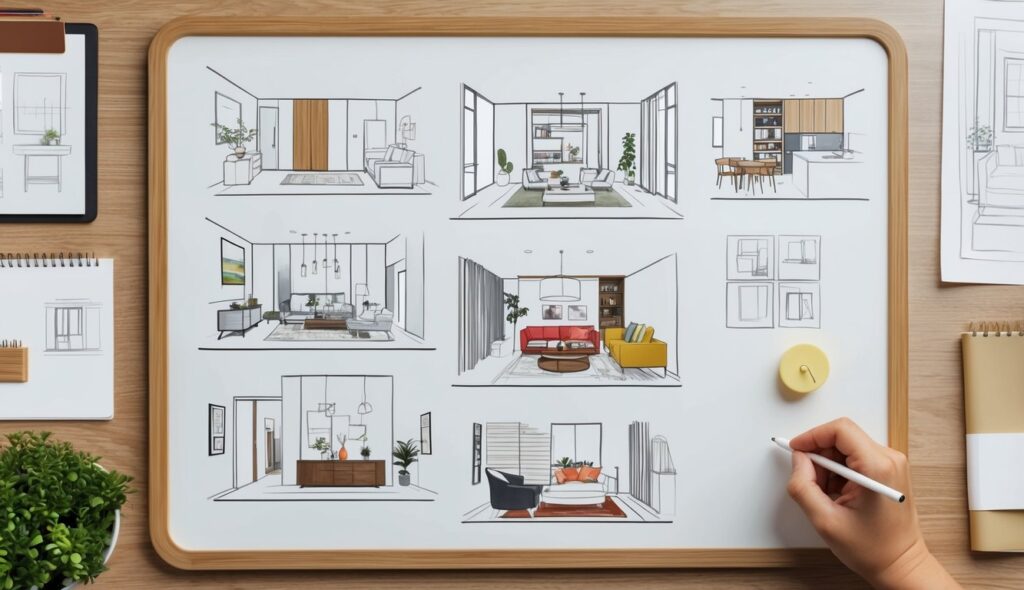Have you ever wondered what to do with all those paint samples and color swatches lying around your home?
Remember to repin your favorite images!
Transforming your space, both interior and exterior, starts with using those leftover paint samples in creative ways.
From crafting geometric artwork to revamping old furniture, the possibilities are endless and cost-effective.
Imagine turning a plain canvas into a modern masterpiece with just some painter’s tape and a few paint samples.
Whether you’re adding a pop of color to your kitchen utensils or creating unique chalk paint for a vintage look, these simple yet effective projects breathe new life into your surroundings.
For exterior use, consider using small amounts of paint to touch up outdoor furniture or create decorative planters.
This not only elevates your home’s curb appeal but also ensures that no paint goes to waste.
Embracing these ideas will not only save you money but also add a personal touch to your living space.
Understanding Paint Samples and Their Uses
Selecting the right paint color for your space involves more than just picking a shade you like.
It’s about seeing how it looks in different settings and light conditions.
Types of Paint Samples and Their Formats
There are various forms of paint samples to choose from.
Liquid samples let you paint a small section of your wall to see the actual color in your space. These usually come in about 8 oz containers.
Another option is peel and stick paint samples. Brands like Samplize offer these convenient, mess-free samples.
Lastly, brush-on color samples involve using small amounts of real paint on your wall, giving you a true sense of how the color will look.
Innovative Tools for Visualizing Paint Samples
Several tools help you visualize paint colors in your space without painting a single wall.
One such tool is a color visualizer. It lets you upload a photo of your room and virtually paint it.
These tools are particularly helpful when you want to see how different shades look on your walls. Some apps even offer suggestions based on light and room function.
Test Painting and Evaluating Color in Different Lighting
Testing paint colors in various lighting is crucial.
Paint a sample patch on different walls to see how the color changes throughout the day with natural light and artificial light.
An 8 oz liquid sample can cover multiple areas, allowing you to see the color in different lighting conditions. This helps ensure the color looks good both day and night.
Practical Tips for Using Paint Samples at Home
Using paint samples effectively can transform your space.
Picking the right placement for your samples, utilizing their size wisely, and coordinating them to create a cohesive look are crucial steps.
Smart Choices for Sample Placement
When placing paint samples, aim to test them in various parts of the room. This helps you see how the color looks in different lighting conditions.
For instance, place samples near windows to observe color changes throughout the day.
Test samples on each wall, and also on different rooms such as the living room, dining room, or bedroom to see the impact on the room’s ambiance.
Don’t forget areas like trim and furniture surfaces for a comprehensive view. Use large swatches of paint for better visibility.
Making the Most of Sample Sizes
Making full use of your paint samples involves painting larger sections. An A5 sheet or larger works well, as it provides a broader color display.
Paint onto foam core or poster board so you can move the samples around different areas of the room.
Using two coats in an eggshell finish offers the best paint color representation.
This approach lets you see how the interior paint shade interacts with different surfaces and lighting conditions. This technique is handy for both interior and exterior paint choices.
Creating a Cohesive Color Scheme
To create a cohesive color scheme, coordinate your paint samples with existing elements in your home.
Look at your furniture, trim, and fixed elements like countertops in the kitchen or bathroom.
Matching sample colors with these elements will help ensure a harmonious look.
Designers often recommend creating a color palette that flows smoothly from room to room.
Consider how colors interact between connecting spaces, like the hallway leading from the living room to the dining room.
Place color ideas next to each other for a clear vision of the final outcome.
Testing thoroughly can help refine your choices and ensure satisfaction with your final paint selections.
This method aligns with practical advice from paint stores and experts on sample usage.

